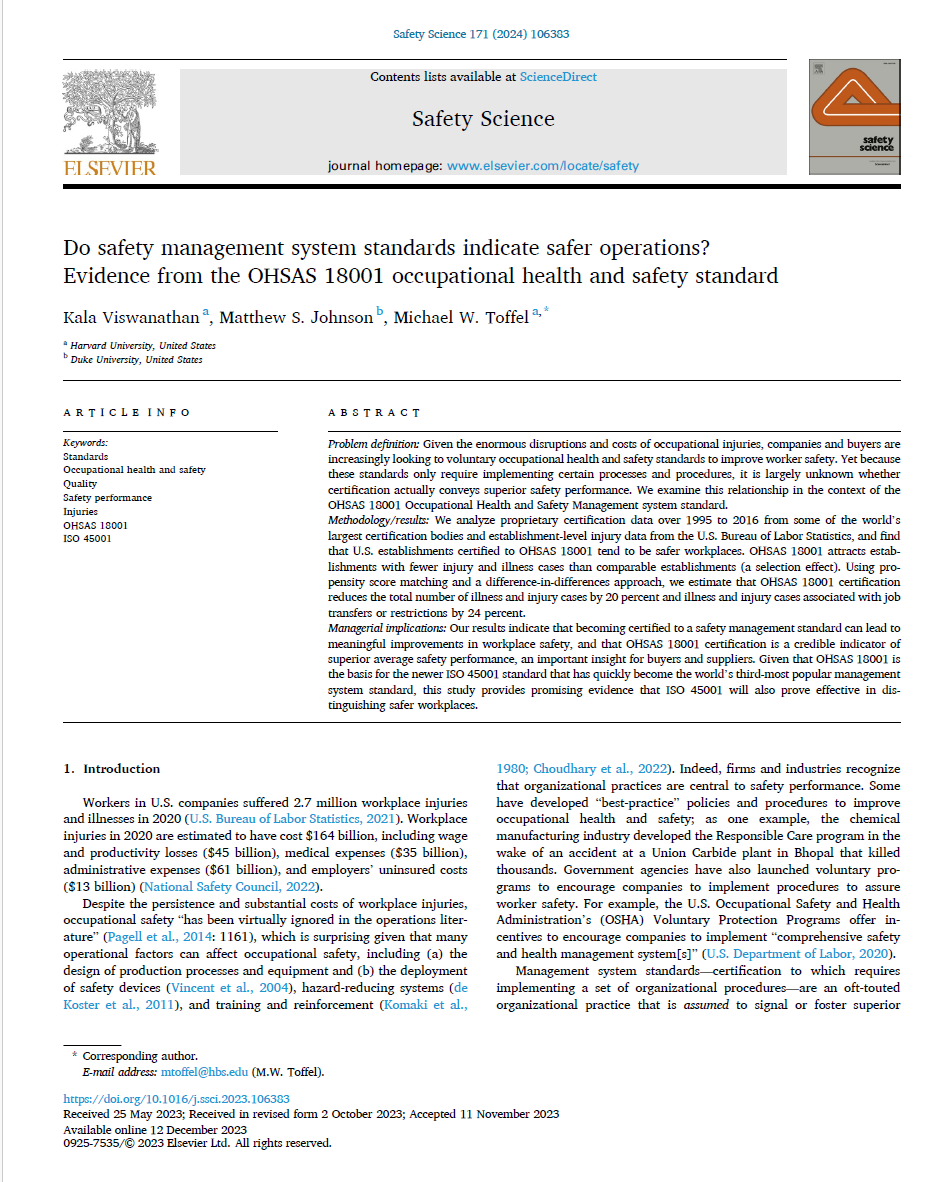Research shows positive impact of health & safety certification
January 31, 2024
Following January 2022’s release of a working paper of research from Harvard Business School and Duke University (New health & safety research shows value of certification – IIOA), the full article has now been published in Safety Science.
The research sought to understand the relative health and safety performance of organisations who were certified to the occupational health and safety standard – OHSAS 18001 – and those who did not have this certification. OHSAS 18001 was the predecessor to ISO 45001 Occupational health and safety Health and Safety – IIOA, the ISO standard which has established itself as management system standard with the third most number of accredited certificates across the globe, behind the quality management system ISO 9001 Supply Chain – IIOA and the environmental management system ISO 14001 Sustainability – IIOA.
The source of data on health and safety performance came from US Bureau of Labor Statistic U.S. Bureau of Labor Statistics (bls.gov)
Following the working paper stage, ‘Do safety management system standards indicate safer operations? Evidence from the OHSAS 18001 occupational health and safety standard’ which was authored by Kala Viswanathan (Harvard Business School), Matthew S. Johnson (Duke University) and Michael W. Toffel (Harvard Business School) is published on 31 January 2024 in Safety Science 171 (2024) 106383.
As the Abstract (quoted below) states, ‘this study provides promising evidence that ISO 45001 will also prove effective in distinguishing safer workplaces.’ This conclusion leads from the two main discussion points in the research:
‘We find that U.S. establishments that became certified to OHSAS 18001 tended to already be safer than comparable workplaces. Each additional injury and illness case was associated with a 21-percent decline in the odds that an establishment became certified to OHSAS 18001, and each additional case of the most severe type of injury and illness we studied—those resulting in days away from work—is associated with a 36-percent decline in the odds of becoming certified. This positive selection effect indicates that OHSAS 18001 certification is a credible signal of ex ante superior safety performance.
We also find that establishments certified to OHSAS 18001 subsequently became safer workplaces by reducing injuries to a greater extent than a matched set of noncertified establishments, revealing a treatment effect. OHSAS 18001 certification reduces the total number of illness and injury cases by 20 percent and the number of illness and injury cases associated with job transfers or restrictions by 24 percent. We find some evidence that OHSAS 18001 also reduces the most severe injuries and illnesses—those that lead to days away from work—by a similar magnitude, though the precision of this estimate was somewhat sensitive to specification.’
Citation: Viswanathan, Kala, Matthew S. Johnson, and Michael W. Toffel. “Do Safety Management System Standards Indicate Safer Operations? Evidence from the OHSAS 18001 Occupational Health and Safety Standard.” (50 days free access from 15 February 2024) Art. 106383. Safety Science 171 (March 2024).
Abstract
Problem definition: Given the enormous disruptions and costs of occupational injuries, companies and buyers are increasingly looking to voluntary occupational health and safety standards to improve worker safety. Yet because these standards only require implementing certain processes and procedures, it is largely unknown whether certification actually conveys superior safety performance. We examine this relationship in the context of the OHSAS 18001 Occupational Health and Safety Management system standard. Methodology/results: We analyze proprietary certification data over 1995 to 2016 from some of the world’s largest certification bodies and establishment-level injury data from the U.S. Bureau of Labor Statistics, and find that U.S. establishments certified to OHSAS 18001 tend to be safer workplaces. OHSAS 18001 attracts establishments with fewer injury and illness cases than comparable establishments (a selection effect). Using propensity score matching and a difference-in-differences approach, we estimate that OHSAS 18001 certification reduces the total number of illness and injury cases by 20 percent and illness and injury cases associated with job transfers or restrictions by 24 percent. Managerial implications: Our results indicate that becoming certified to a safety management standard can lead to meaningful improvements in workplace safety, and that OHSAS 18001 certification is a credible indicator of superior average safety performance, an important insight for buyers and suppliers. Given that OHSAS 18001 is the basis for the newer ISO 45001 standard that has quickly become the world’s third-most popular management system standard, this study provides promising evidence that ISO 45001 will also prove effective in distinguishing safer workplaces.
Related news
Carousel items
-
 Monday June 9, 2025
Monday June 9, 2025World Accreditation Day 9 June 2025 – Accreditation empowering SMEs
-
 Monday June 2, 2025
Monday June 2, 2025Accreditation: Empowering Small and Medium Enterprises: World Accreditation Day 9 June 2025 events
-
 Thursday May 22, 2025
Thursday May 22, 2025Intertek trading statement January-April 2025
-
 Thursday May 8, 2025
Thursday May 8, 2025TÜV SÜD publishes its 2024 Annual Report
-
 Thursday April 24, 2025
Thursday April 24, 2025SGS reports Q1 2025 results
-
Thursday April 24, 2025
Bureau Veritas Q1 2025 results
-
 Wednesday April 23, 2025
Wednesday April 23, 2025BSI 2024 full year results
-
 Wednesday April 23, 2025
Wednesday April 23, 2025DEKRA 2024 full year results
